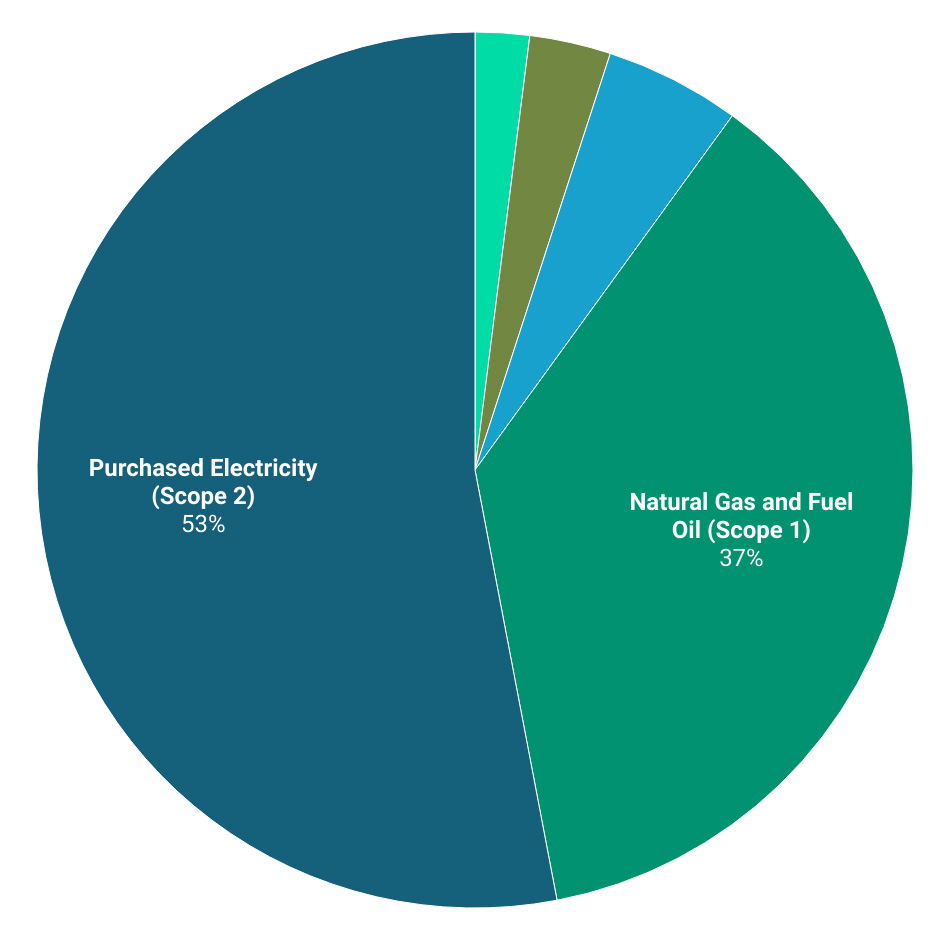The University’s GHG emissions footprint area portfolio includes the following: Reynolda campus core, Real Estate Properties, Historic Reynolda (including Reynolda House, Reynolda Village, and Graylyn), adjacent student housing, adjacent academic and administrative properties, and all Athletics venues. The university does not include leased properties within the boundary.
Wake Forest’s in-house Facilities & Campus Services Utilities Operations team tracks GHG emissions through the accounting framework developed by the science-based non-profit organization Clean Air, Cool Planet. The university’s GHG emissions inventory includes the impacts of all GHGs normalized by carbon dioxide equivalent, or “CO2e,” calculations for ease of comparison. This also allows for emissions of gasses with different global warming potential, including radiant forcing capacities and persistence in Earth’s atmosphere, to be calculated in equivalent terms.
The university’s carbon emissions inventory includes Scope 1 and Scope 2 emissions as defined below. The exception is the inclusion of emissions from utility transmission and distribution (T&D) losses, which are considered Scope 3 emissions.
Scope 1 includes on-site generation sources, including combustion of fossil fuels (natural gas, fuel oil, fleet fuel), refrigerants, and fertilizer application. In FY23, natural gas and fuel oil constituted 37% of the GHG emissions footprint (Figure 1.0).
Scope 2 includes purchased electricity from Duke Energy to power our campus’ electric needs. In FY23, Scope 2 emissions constituted 53% of our GHG emissions (Figure 1.0).

Figure 1.0 Metric Tons CO2e in FY23 by Source
Wake Forest measures Scope 1 and 2 emissions. The exception is our utility transmission and distribution losses, which are Scope 3 emissions.
- Refrigerants (Scope 1) (2%)
- Fleet Vehicle Fuel (Scope 1) (3%)
- Utility Transmission and Distribution Losses (Scope 3) (5%)
- Natural Gas and Fuel Oil (Scope 1) (37%)
- Purchased Electricity (Scope 2) (53%)
Notes on Scope 3 Emissions:
Scope 3 emissions result from the operations of third parties across our value chain. While not directly controlled by a university like ours, these emissions are increasingly considered attributable to institutions across sectors, especially those responsible for the production of goods.
We are engaged in ongoing consideration of the inclusion of upstream Scope 3 emissions from university-sponsored air travel. With cross-cutting research taking place across the globe and 80% of undergraduate students choosing to study away, air travel is an unavoidable part of fulfilling our institutional mission. Additionally, with the FY25 expansion of the ACC to include Stanford, California, and SMU, our athletic teams now travel as far as Texas and California for regular-season play. While we can continue to seek ways to optimize the efficiency of travel by right-sizing vehicles and coordinating travel across teams, modes of long-distance travel are not often discretionary. As with all Scope 3 emissions, we can continue to advocate for airlines’ mitigation of the GHG impacts from their operations.
Given the university’s purchasing power, we can work through procurement processes to hold suppliers of goods and services accountable for the emissions that result from their operations. By influencing accountability across the supply chain, we can impact the larger system of goods and services that we receive. As a sector, higher education could influence practice and policy in this area.
